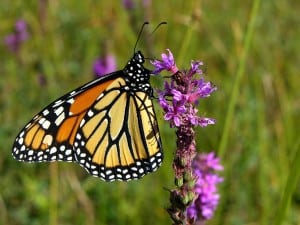On July 29, Chip Taylor, University of Kansas professor of ecology and evolutionary biology, and founder and director of Monarch Watch. posted this on Monarch Watch Blog :
“Those of you who follow monarchs closely are aware that the monarch population has been declining for the last 10 years with significant drops in the population each of the last three years. The number of trees and total area occupied by monarchs in the oyamel fir forests in Mexico was at an all time low last winter – a mere 0.67 hectares. This decline has given rise to a great deal of concern about the future of the monarch migration. These concerns have resulted in many meetings and plans, and even a Presidential Memorandum directing federal agencies to devote resources to offset the decline in monarchs and pollinators. We have addressed this issue through our Monarch Waystation, Bring Back the Monarchs and Milkweed Market programs. These programs are growing but they need to become much, much larger to sustain the monarch migration. Large-scale habitat restoration, particularly in the upper Midwest, also needs to become a priority. In the meantime, we need to keep tagging monarchs as a way of monitoring their numbers and tracking any shifts in the origins of monarchs that reach Mexico. If you are a long-term tagger, you know it has been increasingly difficult to find enough monarchs to tag, especially during the last two years. The totals tagged each year roughly parallel the numbers recorded in Mexico each winter, giving us an independent assessment of the numbers in the migration. Regional tagging success also helps in that it demonstrates how monarchs respond to the physical conditions and quality of the habitats in these areas. Thus, tagging is an important tool to help us understand the overall dynamics of the monarch population.
So what should we expect this year? I usually like to wait until August to make predictions about the numbers in the migration and avoid bold assertions about the size of the overwintering population until well into the migration. However, this year I’m on record as early as the 3rd of May on our discussion list Dplex-L as predicting that there will be a modest increase in the number of monarchs in the migration and at the overwintering sites this winter. “Modest increase” is a vague term and I can’t put a number to it; however, all of the factors I’ve researched indicate that there will be more monarchs migrating this fall and at the overwintering locations by mid December when the colonies are measured. All in all things are looking up for monarchs this year.
Here is a brief overview of factors supporting my prediction of a modest increase in the number of monarchs this fall:
1. I looked at reports from those visiting the overwintering sites about the mortality seen at the colony locations. I also watched the weather in Mexico to be sure that there were no unusual weather events at the overwintering sites that would contribute to mortality. Fortunately, though the population was low, it seemed to winter well.
2. I followed the first sightings reported to Journey North and monitored, as closely as I could, the conditions of the milkweed and flowering of nectar sources in Texas. Since lower than normal temperatures in Texas in March and early April are also associated with an increase in the population, I monitored the temperatures in the region as well. Again, all the signs pointed to a slight growth in the population.
3. The temperatures during May and early June are another key to population growth. These temperatures largely determine when the first generation monarchs coming out of Texas and Oklahoma will reach the northern breeding area. Past records have shown that the timing of arrival of these monarchs in the north (i.e., >40N) is also critical. First sightings suggested fair numbers arrived during the critical period in the upper Midwest, smaller numbers arrived later in MI, OH and ONT and, still later, even fewer reaching the New England area. All of which suggested that most of the increase would come from the upper Midwest assuming that summer temperatures were normal or above normal.
4. A look at the longer-term temperatures suggested that normal temperatures could be expected over most of the northern breeding area, further supporting my optimistic outlook through May and early June.
5. The reports so far this July have not been disappointing. The 4th of July butterfly counts supported by the North American Butterfly Association, and other counts, have generally reported better numbers of monarchs in their surveys than last year.”
